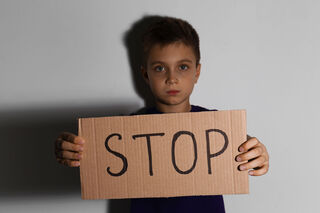Embarrassment
Breaking the Cycle of Abuse: Ongoing Healing and Prevention
Part 5: Revisit your original wounding.
Posted July 30, 2020

This is part of a five-part series.
In order to heal yourself and break the cycle of abuse, you must revisit the original wounding. Unfortunately, most people who were neglected or abused box off their pain and try to put it out of their minds. While this may work to help temporarily ward off their pain, anger, and shame, the feelings are still there on an unconscious level, just under the surface, waiting to be triggered by people and events. When this happens, former victims are likely to lash out at those closest to them—usually their spouse or children—and thus, the cycle of abuse is repeated.
For this reason, it is important to unearth those suppressed and repressed emotions and to reconnect them with the events of your childhood. Needless to say, this will be a difficult process, but an extremely important one. Many people who were neglected or abused stay stuck and never move through their feelings of pain, anger, fear, and shame. Instead, they project them onto those around them. Others turn these feelings back on themselves and punish themselves with them.
You will undoubtedly need help in dealing with all these strong emotions. At this point, I suggest you enter counseling or join a therapy or support group for survivors in order to get the help you need. For now, allow yourself to experience whatever it is that you are feeling and remember the following:
- Even though it may feel like it is happening in the present, it will help if you remind yourself that what you are experiencing are memories of the events and feelings you had as a child—they are not actually happening now. You have already survived your childhood and the painful things that happened to you.
- It helps if you breathe into an emotion. As it is with physical pain, if you breathe into it, it tends to decrease and become less overwhelming.
- Remind yourself that as powerful and overwhelming as emotions can be, they are actually positive forces intended to help you process an experience.
- Allowing yourself to feel and express your hidden emotions from the past will help heal you from the past.
Exercise: Your Feelings About the Abuse
1. Make a list of all the ways you were neglected or abused as a child. Once you have completed your list (it may take you days or weeks to do so) write about each experience focusing on:
- How you felt at the time.
- The effect the neglect or abuse had on you at the time.
- How you feel now as you remember the experience.
- What effect you believe the experience has had on you long-term.
As you write about each incident of neglect or abuse, allow yourself to feel whatever emotions come up for you. It is appropriate for you to feel angry, enraged, afraid, terrified, sad, grief-stricken, guilty, ashamed, or any other emotions you may feel. On the other hand, do not become alarmed if you do not feel anything. Survivors of childhood and neglect often numb themselves to their feelings as a self-protective mechanism.
2. If at all possible, share your writings with at least one other person. Most victims of childhood neglect or abuse did not have what is called a compassionate witness to their pain and anguish. Telling a loved one about what happened to you and receiving your loved one’s support and kindness can be a major step in the healing process. For example, experts such as Alice Miller have found that a sympathetic and understanding witness to a child’s suffering is a crucial prerequisite to empathy in adulthood. Without empathy, we cannot be sensitive to the pain of others.
Continue to Heal Your Shame
Shame is a feeling deep within us of being exposed and unworthy. When we feel shame, we want to hide. Most people who have been deeply shamed take on the underlying and pervasive belief that they are defective or unacceptable. They feel unworthy, unlovable, or “bad.” Shame can also cause us to feel isolated—set apart from the crowd. In fact, in primitive cultures, people were “banished” from the tribe when they broke society’s rules. Being shamed feels like being banished—unworthy to be around others.
Shame is a natural reaction to being abused. In fact, abuse, by its very nature, is humiliating and dehumanizing. There is a feeling of being invaded, defiled, and the indignity of being helpless in the eyes of another person. Although this feeling of being invaded and defiled occurs most profoundly in the case of child sexual abuse, it occurs with all forms of abuse.
Emotional abuse has been described as an assault on the soul and in some cases, has been described as “soul murder.” Constant criticism, name-calling, belittling, unreasonable expectations and other forms of emotional abuse can be just as harmful, and just as shame-inducing as physical or sexual attacks—in fact, some experts, including myself, believe that the negative effects of emotional abuse last longer and have more far-reaching consequences than other forms of abuse.
Child neglect can also create shame in a child. To a child, the thinking goes like this, “If my own mother doesn’t love me enough to take care of me, I must be worthless.” How else can a child interpret being neglected or abandoned by a parent?
Victims of childhood abuse also tend to feel shame because as human beings we want to believe that we have control over what happens to us. When that personal power is challenged by a victimization of any kind, we feel humiliated. We believe we “should have” been able to defend ourselves. And because we weren’t able to do so, we feel helpless and powerless. This powerlessness causes us to feel humiliated—which leads to shame.
Shame is by far the most damaging aspect of abuse and neglect. Therefore, it is important for you to stop blaming and shaming yourself for what your parents and other caretakers did to you. There are two major ways to do this: 1) offer yourself self-compassion for your suffering (refer to my previous post for an introduction as to how to practice self-compassion or read the reference books I have listed below), 2) let yourself get angry at those who hurt you. Here is some important information about anger that will help you do this.
- Anger is the opposite of shame. When we allow ourselves to feel our righteous anger at having been abused, we empower ourselves. We are essentially saying, “I was harmed and I am angry about it. You had no right to harm me in these ways.”
- Many former victims fear that if they allow themselves to express their anger they will become like the abusive people who harmed them. While this is an understandable fear, it is not likely. In fact, the more you suppress or repress your anger, the more likely you are to become abusive toward those around you.
- When we suppress or repress our anger we tend to turn it against ourselves and this can cause shame, depression, and low self-esteem.
So find a healthy, constructive way to deal with your anger at having been abused. Write letters you do not send. Don’t censor yourself, say exactly what you want and need to say. Put a pillow over your head and scream or go for a drive to an isolated place and scream at the top of your lungs. Yell things like: “No!” “Stop it!” or “I hate you.” Kneel beside your bed and hit your bed with your fists.
By following the five steps discussed in this series, you will be doing your best to break the cycle of abuse, and by doing so, you will be offering those around you the best gift possible.
References
Engel, Beverly. (2015) It Wasn't Your Fault: Freeing Yourself from the Shame of Child Abuse with the Power of Self Compassion. Oakland: New Harbinger.
Engel, Beverly (2005) Breaking the Cycle of Abuse: Moving Beyond Your Past to Create an Abuse-Free Future. Hoboken, New Jersey: John Wiley and Sons.




